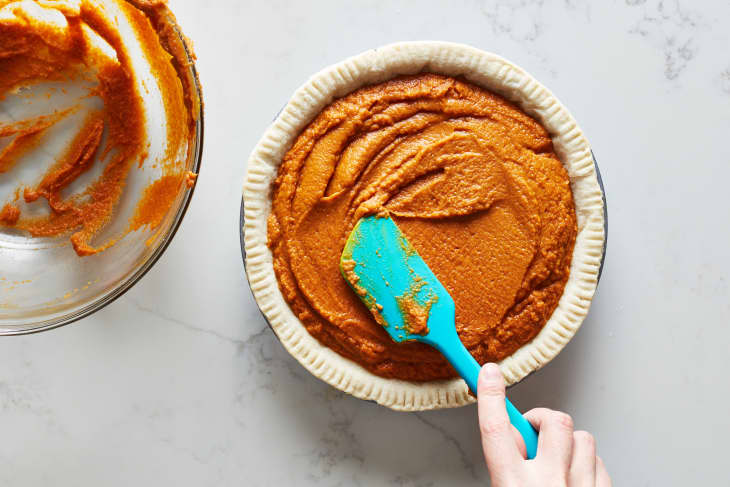What’s Actually in Your Canned Pumpkin Purée?
It’s that special time of year when we make doubly sure our pantries are stocked with multiple cans of pumpkin purée. It’s an essential ingredient in getting our seasonal pumpkin fix; we use it in everything from pumpkin pie to pumpkin chili.
Which begs the question: What exactly is in canned pumpkin purée? Home cooks and professional chefs alike rely on pumpkin purée for its convenience, consistent flavor, and texture. Here’s what you need to know about canned pumpkin purée, including exactly what’s in it, the best brands to buy, and our favorite recipes that showcase it.
What is Pumpkin Purée?
Pumpkin purée is simply cooked and mashed pumpkin. This popular pantry staple adds a orange color and subtle nutty sweetness to pies, muffins, soups, chili, and more. Pumpkin purée can be homemade with whole pumpkin or canned and sold in grocery stores. Canned pumpkin purée that says “100% pumpkin” on the label may also contain one or more types of winter squash, like butternut, Hubbard, Boston Marrow, and Golden Delicious.
Ingredients in Canned Pumpkin Purée
In theory, canned pumpkin purée needs just one ingredient — pumpkin. However, it’s a bit more complicated than this. As it turns out, some canned pumpkin purée is actually made from one or more types of winter squash, like butternut, Hubbard, Boston Marrow, and Golden Delicious.
So then, why might the label say “100% pumpkin?” The USDA is actually pretty lenient with its distinction between pumpkin and squash. Their Standards for Grades of Canned Pumpkin and Canned Squash state: “The canned product prepared from clean, sound, properly matured, golden-fleshed, firm-shelled, sweet varieties of either pumpkins and squashes by washing, stemming, cutting, steaming, and reducing to a pulp.”
The term “pumpkin” can apply to two of the three varieties of winter squash: C pepo and C maxima. Within these two varieties you’ll find Connecticut field pumpkins, Dickinson pumpkins, and Kentucky field pumpkins, as well as Boston marrow squash and Golden Delicious squash. These squash varieties can be less stringy and richer in sweetness and color than pumpkin.
TL;DR: Even though your canned pumpkin purée says “100% pumpkin” on the label, there may also be squash mixed in because they fall under the same genus.
What’s the Best Canned Pumpkin Purée To Buy?
This is entirely up to you. If you’ve been using a specific brand of pumpkin purée for years and you’re happy with the taste, keep on using it! On the other hand, if you want to be sure the purée you’re using is 100 percent pure pumpkin, you have a few options.
A solid option is Libby’s 100% Pure Pumpkin, which you’ll find on the shelves of most grocery stores. They use a strain of Dickinson pumpkins, with especially creamy flesh, that the company developed themselves. It’s also interesting to note that this variety more closely resembles a butternut squash than the orange pumpkin on your front porch.
If you aren’t able to find Libby’s, another favorite is Baker’s Corner 100% Pure Pumpkin, available at Aldi stores. Our editors applaud this canned pumpkin purée for its “deeper orange” color, “light yet distinct scent”, and “mild yet enjoyable flavor.”
And if you really want to be absolutely sure you’re using pure pumpkin purée, you can always skip the canned stuff and make your own.
What to Do With Canned Pumpkin Purée
Once you’ve stocked up on your favorite brand of canned pumpkin purée, put it to use in one of our favorite recipes:
If you have a little bit leftover in the can, don’t let it go to waste. There are plenty of ways to use leftover pumpkin purée, from homemade pumpkin spice latte to stovetop mac and cheese.
How to Store Canned Pumpkin Purée
According to the USDA’s Shelf-Stable Food Safety guide, low acid canned goods such as pumpkin can be stored unopened for 2–5 years in a cool, dry place such as your kitchen pantry. They can be stored after opening in the refrigerator for 3–4 days.
Store any leftover pumpkin purée in a plastic or glass storage container in your refrigerator to preserve its flavor and quality. If you aren’t planning to use up every last bit, you can always freeze pumpkin puree to enjoy in baked goods, soups, smoothies, and more anytime you want.
